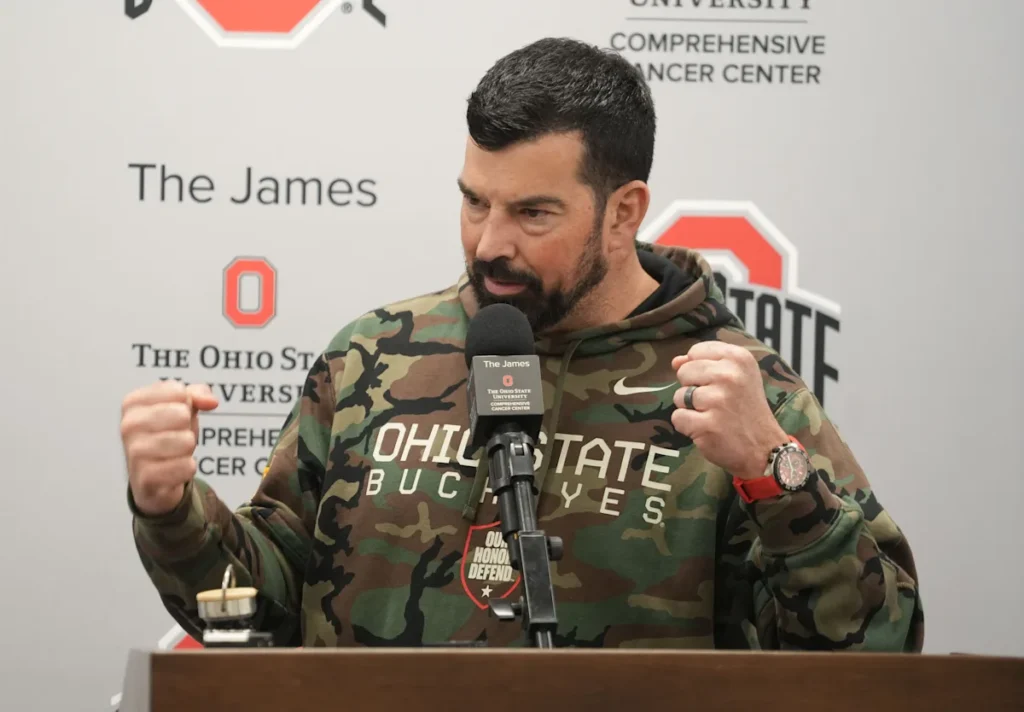Ohio State must trek familiar yet different path to remain on college football mountaintop

Ohio State University has long been a powerhouse in college football. With its storied history, passionate fanbase, and consistent success on the field, the Buckeyes have firmly established themselves as one of the elite programs in the country. However, as college football continues to evolve, Ohio State faces new challenges and opportunities to maintain its position atop the sport.
For decades, Ohio State has been one of the few schools in the country to consistently compete at the highest level. From legendary coaches like Woody Hayes to modern-day innovators like Urban Meyer, the Buckeyes have been a model of consistency. Under Meyer’s leadership, Ohio State not only secured national championships but also established a culture of excellence, strength, and resilience that the program still prides itself on today.
But while Ohio State’s past is rich with success, the future promises a more complex landscape. With the introduction of NIL (Name, Image, and Likeness), the expanded College Football Playoff (CFP), changing conference dynamics, and evolving recruitment strategies, Ohio State faces an entirely different college football environment than the one that brought it to its current heights. To continue its success and remain a contender for national championships, Ohio State must chart a familiar yet different path.
1. The Legacy of Ohio State Football
Ohio State’s success on the football field is rooted in a long history of excellence. Beginning with the likes of Paul Brown and Woody Hayes, the Buckeyes established a dominant culture of physicality, toughness, and discipline. Under Hayes, Ohio State became one of the most formidable forces in college football, capturing five national championships and building a reputation for its tough, hard-nosed brand of football. The 1980s and 1990s saw periods of transition, but the program remained competitive, with iconic figures such as Earle Bruce and John Cooper continuing the winning tradition.
However, the true renaissance of Ohio State football came with the arrival of Urban Meyer in 2012. Meyer inherited a program that had experienced some challenges in the aftermath of the Jim Tressel era, but he immediately returned the Buckeyes to national prominence. His undefeated 2012 team, despite being ineligible for a postseason berth due to NCAA sanctions, set the stage for Ohio State’s future success. Meyer’s teams were marked by innovative offenses, strong defenses, and a relentless will to win. The 2014 national championship, secured with a third-string quarterback in Cardale Jones, remains one of the most remarkable feats in recent college football history.
Despite Meyer’s departure after the 2018 season, Ohio State’s position at the top of the college football hierarchy has remained stable. Under Ryan Day, who succeeded Meyer, the Buckeyes have continued to be a CFP contender, with a high-powered offense and a consistent winning record. Day’s ability to recruit at an elite level and his adaptation to the changing landscape of college football has ensured that Ohio State’s relevance remains strong.
But as the college football world changes, so too must Ohio State. The Buckeyes’ path to continued success will no longer solely rely on the traditional methods that have brought them this far. The landscape of college football is shifting, and Ohio State must adapt to maintain its place atop the sport.
2. The Changing College Football Landscape
The evolution of college football in recent years has been dramatic, especially in terms of recruiting, player compensation, and playoff expansion. The advent of NIL has been particularly significant, as it has created new challenges for Ohio State and all other programs.
NIL and Player Compensation: In 2021, the NCAA finally allowed athletes to profit from their name, image, and likeness, a decision that forever altered the landscape of college sports. While some schools had already found ways to sidestep previous rules, NIL opened the floodgates, allowing athletes to sign endorsement deals, receive compensation from social media platforms, and even start their own businesses. For programs like Ohio State, this new world of recruiting presents both opportunities and challenges.
Ohio State has the advantage of being located in a major media market, offering athletes exposure and opportunities that smaller schools simply cannot match. The presence of large corporate partners and a passionate fanbase gives the Buckeyes a financial edge when it comes to attracting recruits. However, the new NIL world also means that Ohio State must navigate the complexities of ensuring its athletes receive the compensation they deserve while also maintaining a competitive roster. The Buckeyes’ ability to embrace NIL while balancing the demands of competitive recruiting will be critical as they attempt to stay on top.
Recruiting in a New Era: Recruiting has always been the lifeblood of any successful college football program. For Ohio State, its reputation and history of success have made it an attractive destination for top-tier talent. Under Ryan Day, the Buckeyes have continued to land elite recruiting classes year after year, routinely competing for the best players in the country. However, the recruiting game has changed, and Ohio State’s recruiting philosophy must evolve.
The shift towards digital recruiting, early recruiting, and increased player movement through the transfer portal has made recruiting more dynamic and unpredictable. The traditional approach of recruiting high school talent and developing them over the course of several years is no longer enough. College programs must now be able to evaluate talent quickly, make fast offers, and leverage transfer portal opportunities to fill roster needs immediately. Ohio State will need to stay ahead of this curve by maintaining a balance between developing homegrown talent and bringing in immediate impact players from the portal.
Additionally, the emergence of new recruiting landscapes, such as the deepening South, Southeast, and Texas recruiting hotbeds, requires Ohio State to spread its wings even further. The Buckeyes’ footprint in recruiting must extend beyond the Midwest, particularly if they want to continue competing with the likes of Alabama, Georgia, and Clemson, who have dominated the college football playoff scene in recent years.
3. The Expanded College Football Playoff and Its Implications
The announcement of an expanded College Football Playoff (CFP) in 2024 marks another pivotal change in college football. The current four-team playoff has been criticized for its exclusivity, with some arguing that it leaves out deserving teams and leads to predictable outcomes. The expansion to 12 teams is expected to level the playing field and allow more programs to vie for national championships. While the change presents new opportunities for teams like Ohio State to secure their place in the playoff, it also introduces new challenges.
A 12-team playoff will likely result in more games against teams from different conferences, meaning that Ohio State’s path to the national championship will no longer be solely determined by their ability to win the Big Ten. With more teams in the mix, the Buckeyes will face the challenge of maintaining their elite status amid a deeper and more competitive field. The potential for upsets will be greater, and Ohio State will need to be prepared to face a variety of styles of play from teams they may not typically encounter in the regular season.
Furthermore, the expanded playoff means more games, potentially leading to injuries and fatigue for Ohio State’s players. As the program continues to chase national championships, managing player health and depth will become even more critical. For Ohio State, navigating the 12-team playoff requires not only skill and preparation but also a keen understanding of how to preserve players over the long haul of the postseason.
4. The Future of Ohio State Football
In order to remain on the mountaintop of college football, Ohio State will need to continue adapting to the changing landscape. Here are several key areas that the Buckeyes must focus on moving forward:
– Recruiting Innovation: Ohio State must continue to innovate in recruiting. The landscape is no longer about just signing the best players; it’s about identifying talent early, using data analytics to evaluate potential, and leveraging NIL opportunities to attract players. Additionally, Ohio State must continue to recruit nationally, drawing talent from all over the country, particularly from high schools in Southern states where football talent is abundant.
– Coaching Development: Ryan Day has been a proven leader for Ohio State, but as the demands of college football grow, so too must the coaching staff. Day must surround himself with innovative assistant coaches and analysts who can help the Buckeyes stay ahead of the curve in terms of offensive and defensive schemes. Maintaining a strong coaching staff is critical to Ohio State’s long-term success.
– Player Development: As college football becomes more competitive, player development will be key. Ohio State has a long history of turning recruits into high-level NFL talent, but continuing to develop players not only in terms of football skills but also in terms of mental toughness, leadership, and academics will be crucial. Ohio State’s emphasis on player development, including strength and conditioning, academic support, and life skills, will help set it apart from other elite programs.
– Embrace Change: Ohio State has always been a traditional program, but the future of college football is defined by change. Whether it’s embracing NIL, the transfer portal, or new offensive and defensive trends, Ohio State must stay flexible and willing to evolve with the times.
Ohio State football has a proud tradition and a bright future. However, to remain at the pinnacle of college football, the Buckeyes must chart a path that embraces change while staying true to the principles that have made them successful for over a century. By adapting to the new realities of recruiting, player compensation, and playoff expansion, Ohio State can continue to compete for national championships and secure its place as one of the most dominant programs in the country. The journey ahead is familiar in some ways, but in many ways, it will be different—requiring innovation, strategy, and leadership to ensure that Ohio State remains on top of the college football mountain.




